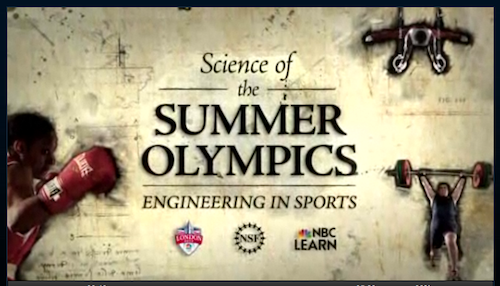Note: NBC Olympics videos have an annoying auto-play function so the videos have been moved off the blog. Please go to "Science of the Summer Olympics: Engineering In Sports", a 10-part video series produced in partnership with NBC Learn to view the videos described in this blog post.
Have you been staring at a television screen, immersed in the Olympics? Are you chewing your nails for the Swiss beach volleyball team or the Luxembourg table tennis team? Do you wonder if they ever really will get back to Greenwich Park and the equestrian events?
We get wrapped up in the competition of sports but the Olympics is a good time to remember that the same sport science that is used to advance horse sports and hoof science is also used on human athletes.
We get wrapped up in the competition of sports but the Olympics is a good time to remember that the same sport science that is used to advance horse sports and hoof science is also used on human athletes.
So whether you are Usain Bolt or Zenyatta, there's a professor at MIT who can dissect your stride. And the same terminology is used whether you're measuring the stride of a track star or a Thoroughbred.
Could the same long-jump technique be used to analyze how Kauto Star won the Cheltenham Gold Cup or how a rider like Meredith Michaels-Beerbaum's horse will clear the water jump at Greenwich Park this weekend?
While you're watching the Olympics, think about the fact that the emerging gait analysis and sport science we see used in horse sports is being applied to each and every one of those Olympic sports. In some aspects, horse sports have lead the way. In other aspects, horse sports have a lot of catching up to do.
So don't think for a minute that you're wasting time watching the Olympics. You're doing your homework, albeit on the subconscious level in many instances. Some creative thoughts about how horses move are sure to pop into your head a week or two from now, and you'll wonder where those thoughts originated.
Maybe you'll never see a horse on a balance beam, but when you think about the pressure to always improve the level of performance while not crossing the line to injury, you realize that all athletes have a lot in common, whether they're horse or human.
These two sample videos are part of "Science of the Summer Olympics: Engineering In Sports", a 10-part video series produced in partnership with NBC Learn. (You can watch them all online and if you're really interested or if you know a teacher who might be, there are lesson plans available to use these videos in the classroom. Just pretend the humans are horses.)
 |
| It's easy to order this colorful, award-winning image from Michigan State Equine Foot Lab |
© Fran Jurga and Hoofcare Publishing; Fran Jurga's Hoof Blog is a between-issues news service for subscribers to Hoofcare and Lameness Journal. Please, no use without permission. You only need to ask. This blog may be read online at the blog page, checked via RSS feed, or received via a digest-type email (requires signup in box at top right of blog page). To subscribe to Hoofcare and Lameness (the journal), please visit the main site, www.hoofcare.com, where many educational products and media related to equine lameness and hoof science can be found. Questions or problems with this blog? Send email to blog@hoofcare.com.
Follow Hoofcare + Lameness on Twitter: @HoofcareJournal
Read this blog's headlines on the Hoofcare + Lameness Facebook Page
Disclosure of Material Connection: I have not received any direct compensation for writing this post. I have no material connection to the brands, products, or services that I have mentioned, other than Hoofcare Publishing. I am disclosing this in accordance with the Federal Trade Commission’s 16 CFR, Part 255: Guides Concerning the Use of Endorsements and Testimonials in Advertising.













